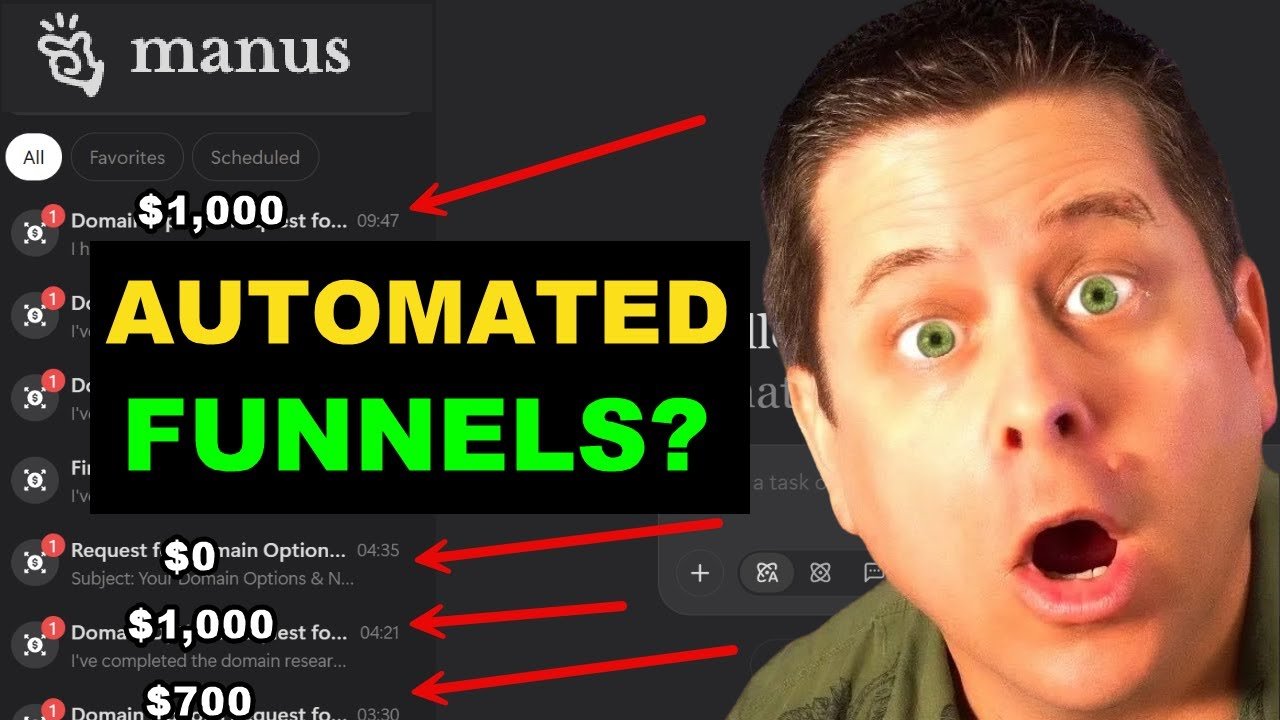Automated sales funnels are stepping into the spotlight as a game changer in the world of AI business. You’ll learn how these innovative tools can streamline your follow-up processes and enhance your ability to connect with leads effectively. By leveraging a straightforward three-step method, you can harness AI technology to better understand your prospects and tailor your sales approach accordingly.
This article explores how you can set up an automated follow-up system using Manus AI without the need for complicated software. It emphasizes the importance of following regulations and providing valuable content while keeping in mind that success varies widely in the online business landscape. You’ll also discover additional resources on maximizing your earnings through AI strategies on platforms like Fiverr and Upwork.
Understanding Automated Sales Funnels
Definition of Automated Sales Funnels
So, let’s talk about automated sales funnels. Picture this: It’s like a well-oiled machine that takes your potential customers through a journey—from a mere stranger on the internet to a loyal paying customer. An automated sales funnel systematically guides people through various stages, using tools and resources that work for you, even while you’re sipping your morning coffee. It’s all about streamlining the process of gaining, nurturing, and converting leads into sales—all on autopilot!
Importance in Modern Business
In today’s fast-paced world, efficiency is your best friend. Automated sales funnels are crucial for modern businesses because they save time, reduce human error, and can be tweaked to fit your unique requirements. When implemented correctly, they lead to higher conversion rates and improved customer engagement. They help you reach your audience 24/7, meaning every hour is an opportunity to generate leads and sales while you focus on other essential aspects of your business.
How They Differ from Traditional Funnels
Traditional sales funnels often rely heavily on human interaction and manual processes. You might remember tracking your leads through spreadsheets or endless meetings. Automated sales funnels, on the other hand, utilize technology to handle much of this workload, leading to quicker responses and consistent follow-ups. Instead of pushing customers through a basic linear path, they create a more dynamic and personalized experience, allowing for better interactions and engagement.
The Role of AI in Sales Funnels
AI Technologies Used in Automated Funnels
Artificial Intelligence (AI) is the secret ingredient to jazzing up your automated sales funnel. Think chatbots, predictive analytics, and advanced data processing. These technologies can analyze user behaviors, assess their needs, and interact in real time, enhancing your customers’ experience. With AI, funnels can become more responsive and tailored to individual user journeys, promoting a higher likelihood of conversion.
Benefits of AI Integration
Integrating AI into your sales funnels provides you with invaluable insights. You’ll benefit from enhanced lead scoring, which allows you to focus on high-potential leads. AI can help you understand customer preferences, making it easier to personalize communication. It also gives you the power to automate follow-up emails, segment your audience effectively, and even predict future trends based on data analysis—essentially giving you a crystal ball for your marketing strategies.
Common AI Tools for Entrepreneurs
There are several AI tools that can supercharge your sales funnel. Tools like HubSpot or Mailchimp offer built-in AI features for email marketing and lead generation. If you want to take it a step further, platforms like Drift and Intercom utilize chatbots to engage visitors in real-time on your website. You may also consider tools like Crystal Knows, which helps you personalize communication by analyzing personality traits, making your follow-ups feel more genuine and tailored.

Building Your Automated Sales Funnel
Step-by-Step Process to Create a Funnel
Creating an automated sales funnel can sound daunting, but it can be boiled down into a few manageable steps. Start by identifying your target audience and understanding their needs. Next, create valuable content that addresses these needs—this might be blogs, videos, or webinars. Then, set up landing pages to capture your leads’ information, offering something of value in return. Once you have the leads, integrate an email marketing system to nurture them with automated follow-up messages. Finally, analyze your funnel’s performance using key metrics and continuously refine your strategy.
Choosing the Right Platforms
The platform you choose can make or break your automated sales funnel. Consider user-friendly options that come equipped with essential features like landing page builders and email automation. Popular choices include Kissmetrics, GetResponse, and ClickFunnels. Look for platforms that offer integrations with your favorite tools to make your workflow seamless. Take your time to explore their features, pricing, and support options—after all, you want something that fits your needs like a good pair of jeans!
Integrating AI Tools and Features
Once you have your platform in place, it’s time to integrate AI tools to elevate your funnel further. Leverage AI chatbots for initial contact on your landing page, which will help engage leads instantly. Use machine learning for predictive analytics, allowing you to anticipate customer needs and tailor your follow-ups accordingly. Make sure to test different AI applications within your funnel, analyzing what works best for your target demographic, adjusting along the way to ensure you create the most effective automated system possible.
Lead Generation Strategies
Using AI for Effective Lead Generation
Who doesn’t love good leads? AI can make the process of generating leads as easy as pie! Utilizing social media algorithms, for example, can help you identify potential leads based on behaviors and preferences. Additionally, AI tools can scrape the internet for relevant data, helping you compile a list of high-potential prospects. With the right strategies, that AI can dig up gold nuggets of highly targeted leads that you might have otherwise overlooked!
Best Practices for Qualifying Leads
Not all leads are created equal! Use lead scoring to prioritize which contacts are most likely to convert. Qualifying leads means determining how well they fit your ideal customer profile and how engaged they are with your content. The more qualified your leads, the better your chance of conversion. Utilize data from your previous sales and integrate AI algorithms to analyze their scores based on engagement metrics like email opens, downloads, and interactions. This way, you can focus your energy on the leads most likely to convert.
Examples of Successful Lead Generation Campaigns
Several companies have made a splash using creative lead generation campaigns. For instance, many SaaS companies offer free trials or freemium models, providing limited features in exchange for user sign-ups. A notable campaign is Dropbox’s referral program, incentivizing existing users to invite their friends. When the friends signed up, both parties received free storage space—literally a win-win! Learning from these examples can inspire your unique campaigns tailored to your audience.

Follow-Up Mechanisms in Sales Funnels
The Importance of Timely Follow-Ups
You’ve generated leads, but don’t let them fade away! Timely follow-ups are critical in keeping your leads engaged and interested. Research shows that the likelihood of conversion decreases significantly with time, so you want to act fast! Whether it’s an email, a phone call, or even a quick text, ensuring you follow up promptly keeps your potential customers in your sales funnel and shows them that you value their interest.
AI-Powered Communication Channels
Imagine having a virtual assistant who never sleeps and is always ready to chat! AI-powered communication channels, such as chatbots and predictive text, can automate follow-up interactions, ensuring no lead falls through the cracks. Chatbots can provide answers to frequently asked questions, while predictive text can help you compose quick response emails tailored to the specific inquiries of your leads. These tools foster a seamless communication experience, keeping your prospects engaged.
Techniques for Personalized Follow-Ups
Personalization can set you apart in a crowded market. Use data to address your leads by name and segment your follow-up messages based on their interests. Including personalized content—like recommending products based on their browsing history—increases engagement rates. Little touches like sending birthday emails or acknowledging anniversaries with your brand can make customers feel special. These tailored interactions may just be what turns a hesitant lead into a loyal customer!
Analyzing Customer Behavior
Utilizing AI to Understand Customer Preferences
Understanding what makes your customers tick is key to a successful sales funnel. AI can analyze customer behavior and provide insights into their preferences, helping you refine your approach. Behavioral tracking tools can reveal patterns in what customers look for, how long they spend on different pages, and what leads them to convert. With this data, you can modify your strategies, improve user-experience, and increase sales.
Predictive Analytics for Better Targeting
Predictive analytics uses historical data and machine learning technology to forecast future trends. By understanding patterns of previous customer behavior, you can predict actions for future customers—like which leads are more likely to convert and how. Such insights allow you to focus marketing efforts on the most promising leads while improving the overall targeting strategy, reducing the chance of wasted resources.
Feedback Loops and Continuous Improvement
Establishing feedback loops is essential for growth. AI can facilitate this by collecting feedback from multiple touchpoints in the customer journey. Analyzing changes in customer sentiment through surveys, reviews, and social media mentions keeps your finger on the pulse of consumer perceptions. Use this data to make continuous improvements to your sales funnel, tweaking operations to better meet customer expectations.

Integrating Multiple Channels
Creating a Multi-Channel Sales Funnel
A multi-channel approach means reaching your customers where they are—whether that’s on social media, email, or your website. By creating a multi-channel sales funnel, you can maximize your reach and ensure your message resonates with a broader audience. Each channel provides unique advantages, and when they are connected, they create a holistic view of customer journeys, allowing you to tailor your strategies more effectively.
Benefits of Omnichannel Marketing
Integrating multiple channels leads to a better customer experience. With omnichannel marketing, your customers have a consistent experience across different platforms, which enhances brand recognition and loyalty. They can interact with your business on their terms, whether they choose to browse on a mobile app or visit your website. By maintaining consistency in messaging and branding, you can build a stronger relationship with customers.
Tools for Channel Integration
There are many tools available to help you achieve successful channel integration. Platforms like Zapier enable you to connect apps and automate workflows without needing coding skills. Social media management tools, like Hootsuite, can streamline your social media posting and advertising across multiple platforms. Email marketing services can also integrate with your CRM for a seamless transition between channels. Choosing the right tools can transform your multi-channel management task from overwhelming to manageable.
Ethics and Transparency in AI Sales
Addressing Concerns about AI in Sales
As with any emerging technology, concerns about AI in sales are valid. Questions arise regarding job displacement, privacy, and how data is utilized. By being transparent about your AI tools and practices, you can alleviate fears. Clearly communicate how you use AI to enhance, not replace, the human touch in customer interactions, showing your clients that their experience remains paramount.
Importance of Customer Trust
Trust is the foundation of any successful business relationship. Ensuring customers trust your AI-driven processes is essential for retention. To foster this trust, keep lines of communication open, provide clear privacy policies, and maintain responsiveness to customer queries. Relying on ethical AI practices strengthens your brand credibility and can lead to long-term customer loyalty.
Legal Considerations and Compliance
Operating an AI-enabled sales funnel comes with legal responsibilities. Familiarize yourself with laws regarding data protection, like the GDPR, which governs how personal data should be handled. Compliance isn’t just about avoiding penalties; it’s also about creating a trustworthy environment for your customers. Demonstrating a commitment to ethical data practices enhances your brand image and reassures customers about their privacy.
Case Studies of Successful Automated Sales Funnels
Reviewing Leading Companies’ Strategies
Take a look at companies like Amazon and Airbnb, whose automated sales funnels are spot-on! Amazon’s recommendations are powered by advanced algorithms analyzing customer data and suggesting products you might love, making shopping a breeze. Meanwhile, Airbnb’s automated email sequences encourage users to complete their bookings while providing personalized suggestions for their travels. Learning from their strategies can help you shape your approach to create equally compelling funnels.
Lessons Learned from Industry Leaders
What’s the biggest takeaway from these industry leaders? Emphasize data-driven decision-making while fostering a personalized experience. Understanding your customer’s journey means you can intervene at critical moments and push them toward conversion. Always be willing to adapt; what works today may not work tomorrow, and agility is your best bet for continued success.
Small Business Success Stories
Don’t think that these strategies only work for big players! Many small businesses have also managed to supercharge their sales through automated funnels. Local coffee shops offering loyalty programs via email marketing increased repeat customers. A small e-commerce site saw fantastic results by implementing cart abandonment emails, leading to conversions that would have otherwise slipped away. Your business could be next!
Conclusion
Recap of Key Points
To wrap this up, we’ve explored what automated sales funnels are, the significant role of AI in their operation, and how you can build an effective funnel. From lead generation strategies to analyzing customer behavior, managing these funnels through an integrated, ethical framework can significantly promote your business growth. Plus, don’t forget how vital customer trust is in ensuring long-term relationships.
Final Thoughts on AI and Business Growth
Artificial intelligence and automated sales funnels are no longer trends; they are here to stay! By jumping on this bandwagon, you’re positioning your business for lasting success in a rapidly changing market. Embrace technology, adopt AI solutions, and watch your business flourish!
Encouragement for Entrepreneurs to Adopt AI Solutions
It might feel overwhelming at first, but fear not! Small steps lead to big changes. Look into AI solutions gradually and figure out which works best for your operations. Dive in, experiment, and most importantly, have fun while transforming your sales processes. The future is bright, and it’s all yours to explore!

